

At Ease With Hand and Mind
Calligraphy, Literature, and Contemporary Art
July 27 – Sept 27, 2025
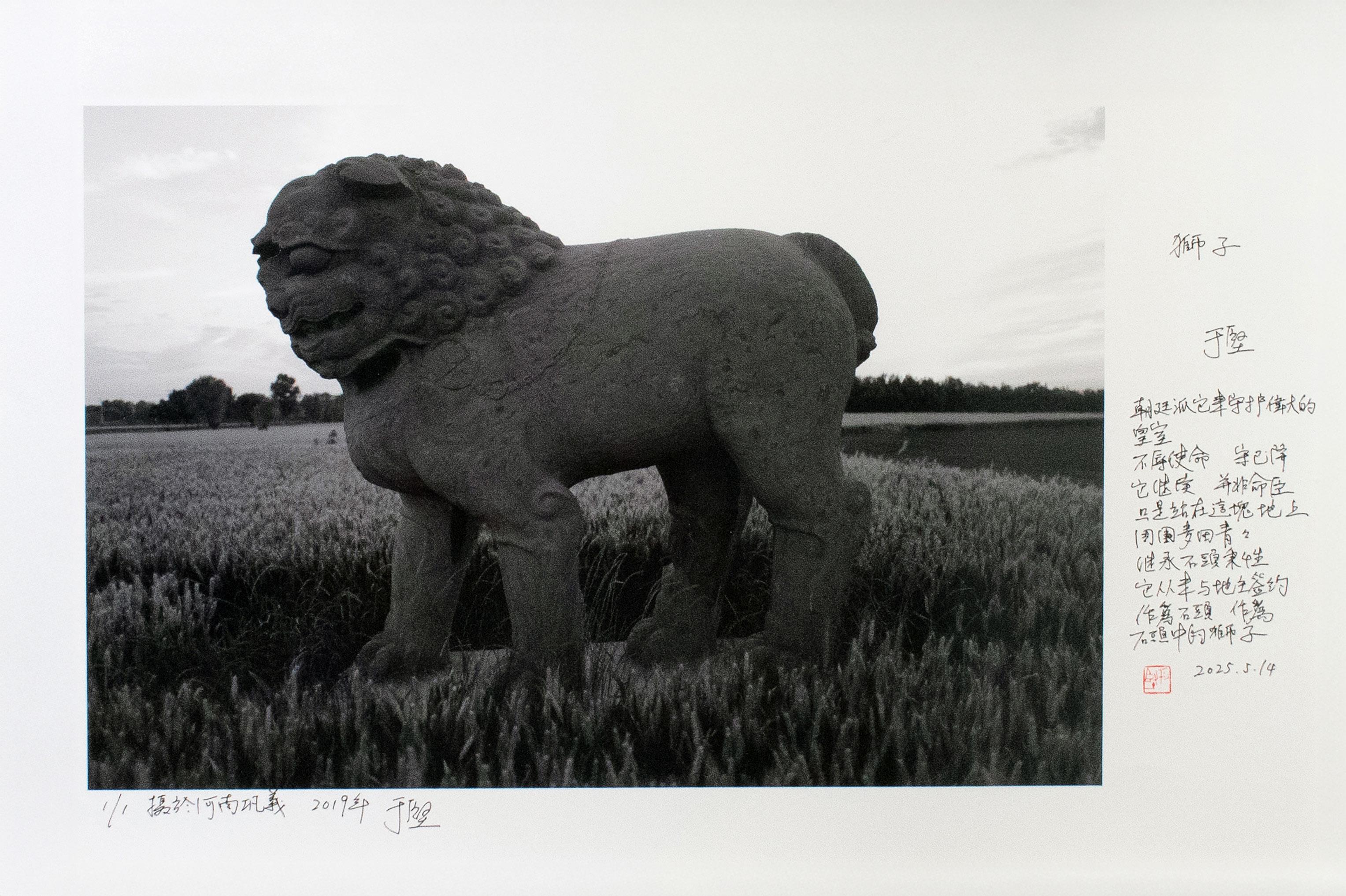

BIOGRAPHY
JIA PINGWA 贾平凹
b. 1952 in Shaanxi, China
Jia Pingwa is one of the most prominent contemporary Chinese writers and chairman of the Shaanxi Writers Association. He graduated from the Department of Chinese Language and Literature at Northwest University in Xi’an in 1975 and began publishing his works in 1974.
His Collected Works of Jia Pingwa spans 26 volumes. His representative novels include Turbulence, Ruined City, Qinqiang, Ancient Furnace, With the Lamp, Old Life, and Shanben. Major works of short and medium fiction include The Heis, Sky Dog, Five Masters, and The Backward-Flowing River. Among his best-known essays and prose are Notes from Shangzhou, Ugly Stone, and Dingxi Notebook.
Jia’s literary achievements have earned him numerous prestigious awards in China and abroad, including the Mao Dun Literature Prize, the Lu Xun Literature Prize, National Prizes for Outstanding Short and Medium-Length Fiction, and the National Prose Prize. Internationally, he has received the Mobil Pegasus Prize for Literature (USA), the Prix Femina Étranger (France), the French Ordre des Arts et des Lettres (Chevalier), the “Dream of the Red Chamber” Prize (Hong Kong), the Chinese Literature Media Award, the Wang Molin–Zhou Anyi Chinese Literature Award (Peking University), the Shi Nai’an Literature Prize, the Contemporary Literature Award, and the People’s Literature Award.
Over fifty of his works have been translated into English, French, German, Swedish, Italian, Spanish, Russian, Japanese, Korean, Vietnamese, and other languages, and published in more than thirty countries.
Jia Pingwa regards calligraphy and literature as kindred arts. For him, calligraphy must convey “narrative, emotion, and a sense of depth,” serving as a medium of emotional expression rather than a mere showcase of technical skill. This view aligns with the literati tradition in Chinese art, which emphasizes cultural substance over formal perfection, echoing the classic ideal of “prioritizing meaning over form” in literati painting.

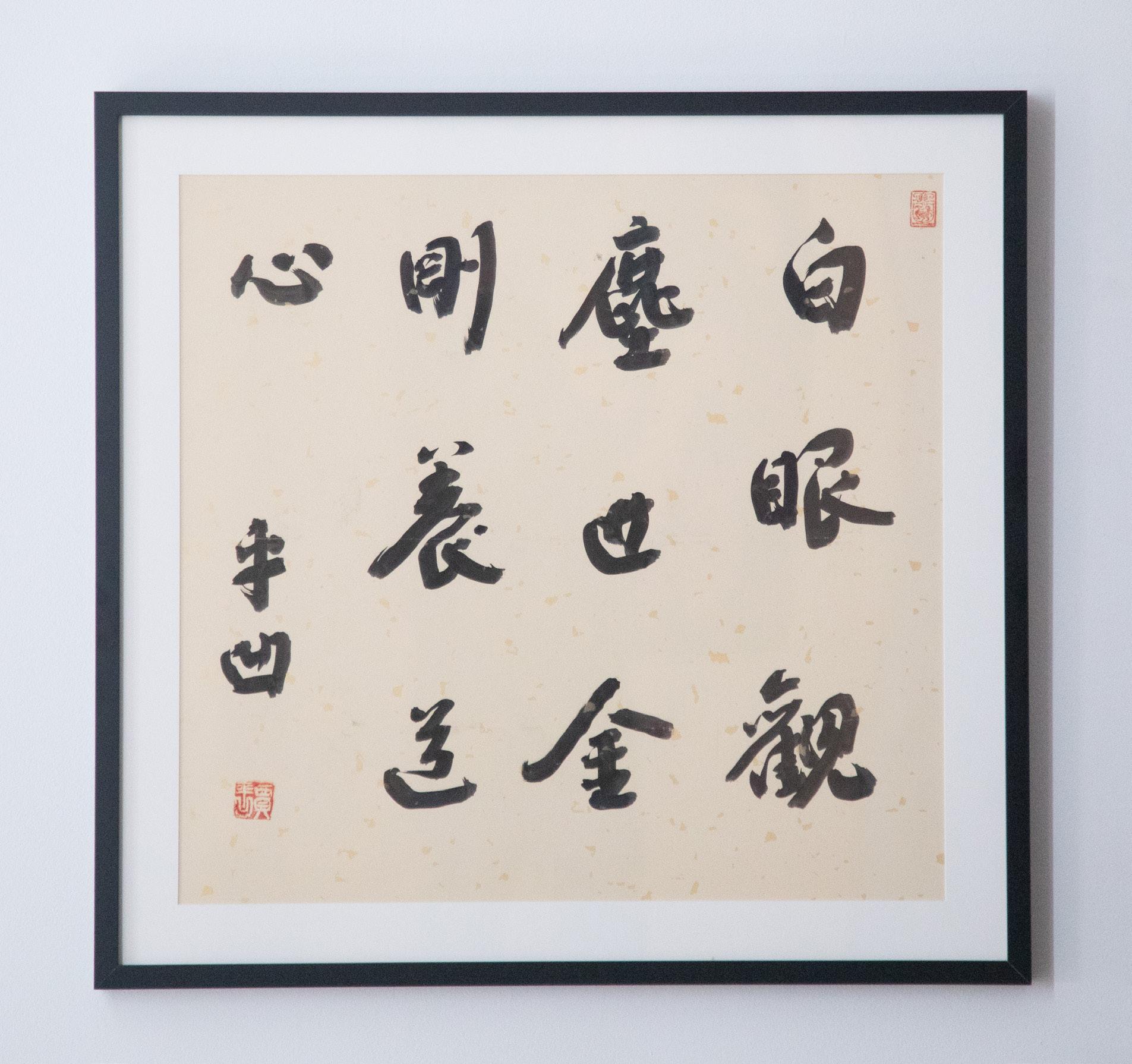
白眼觀塵世 金經養道心
Through white, detached eyes, see the mortal world; with golden scriptures, nurture the heart of the Way, 2025
Ink on xuan paper
67.25 x 70 cm, 26.5 x 27.5 in
Framed: 82.5 x 85.75 cm, 32.5 x 33.75 in

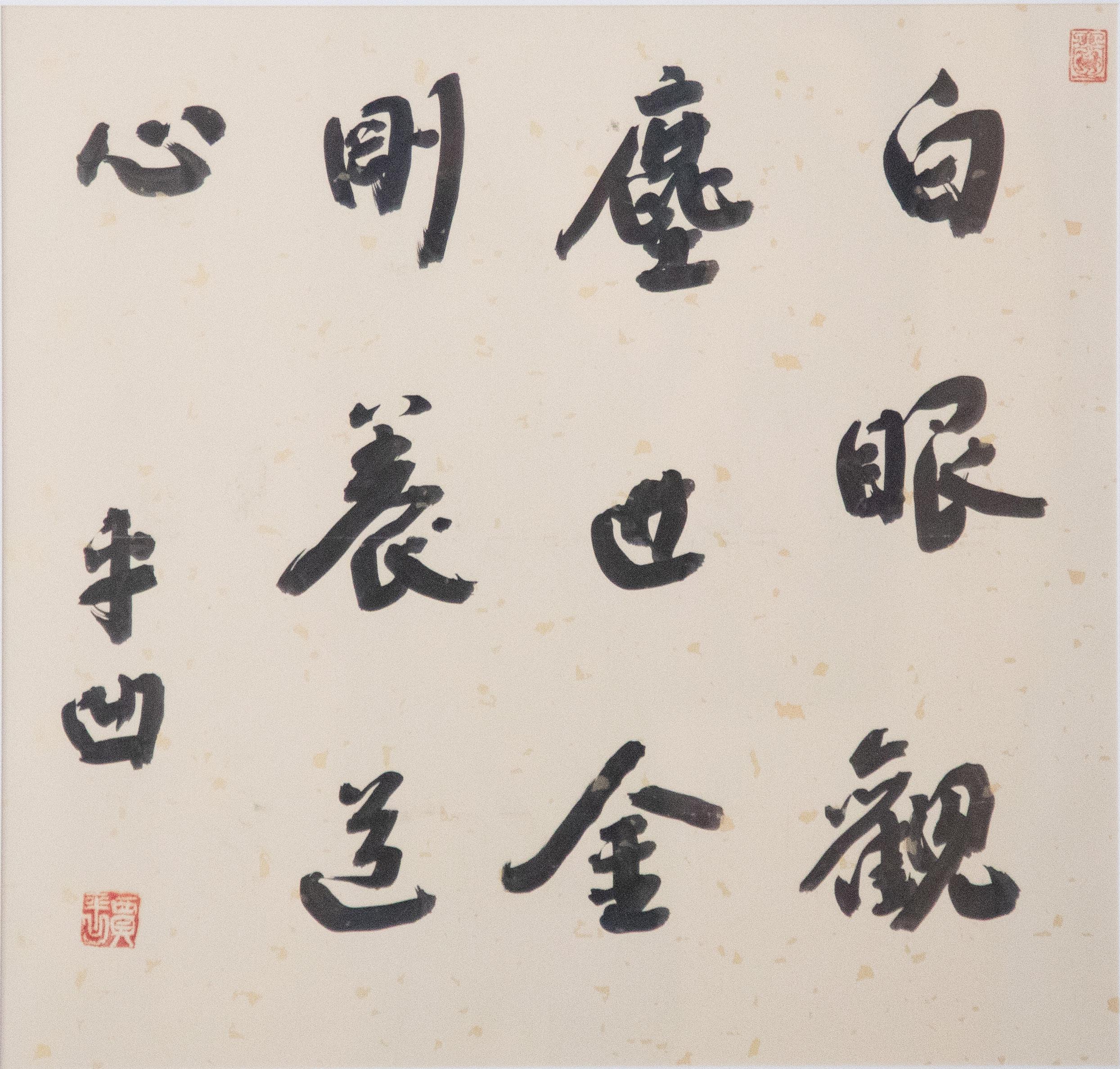
Detail: 白眼觀塵世 金經養道心 Through white, detached eyes, see the mortal world; with golden scriptures, nurture the heart of the Way, 2025

BIOGRAPHY
LI XIANTING 栗憲庭
Li Xianting is widely regarded as one of the most influential figures in the formation of contemporary Chinese art. As an independent critic, curator, and editor, Li has been instrumental in shaping the intellectual discourse and public visibility of China’s avant-garde since the late 1970s. His impact is deeply felt not only through his writing and exhibitions, but also through the communities and movements he has championed—many of which define the trajectory of Chinese contemporary art today.
After graduating in 1978 from the Chinese Painting Department of the Central Academy of Fine Arts in Beijing, Li quickly emerged as a key editorial voice. He served as editor at Fine Art Magazine (《美术》) from 1979 to 1983, and later at the China Fine Art Newspaper (《中国美术报》) from 1985 to 1989. These platforms provided a crucial space for the emergence of critical dialogue during a period of dramatic cultural opening. Li was known for his incisive and daring writing, often advocating for experimental and socially engaged practices at a time when they were still highly contested.
From his base in Beijing, Li championed a generation of artists seeking to push beyond both Socialist Realism and traditional aesthetics. He was a core organizer of the landmark 1979 “Stars” Exhibition (星星美 展), a seminal event in Chinese art history that marked the beginning of the post-Mao avant-garde.
Throughout the 1980s and 1990s, Li continued to write extensively, shaping the discourse around emerging artistic tendencies—including what he famously coined as “Cynical Realism” and “Political Pop.” His critical framing helped solidify these movements as key chapters in China’s engagement with both postTiananmen disillusionment and global contemporary art currents.
Internationally, Li has contributed to numerous exhibitions and symposia, including serving as a curator for the China Pavilion at the 45th Venice Biennale in 1995—one of the earliest institutional presentations of Chinese contemporary art on a global stage. He has been a guest lecturer at universities and museums worldwide and continues to be an essential interlocutor between Chinese artists and the international art world.
In recent years, Li has extended his curatorial and intellectual work into institution-building. He is the founding director of the Songzhuang Art Museum, located in one of China’s most important contemporary art districts, and also oversees Li Xianting’s Film Fund, which supports independent documentary and experimental film in China.

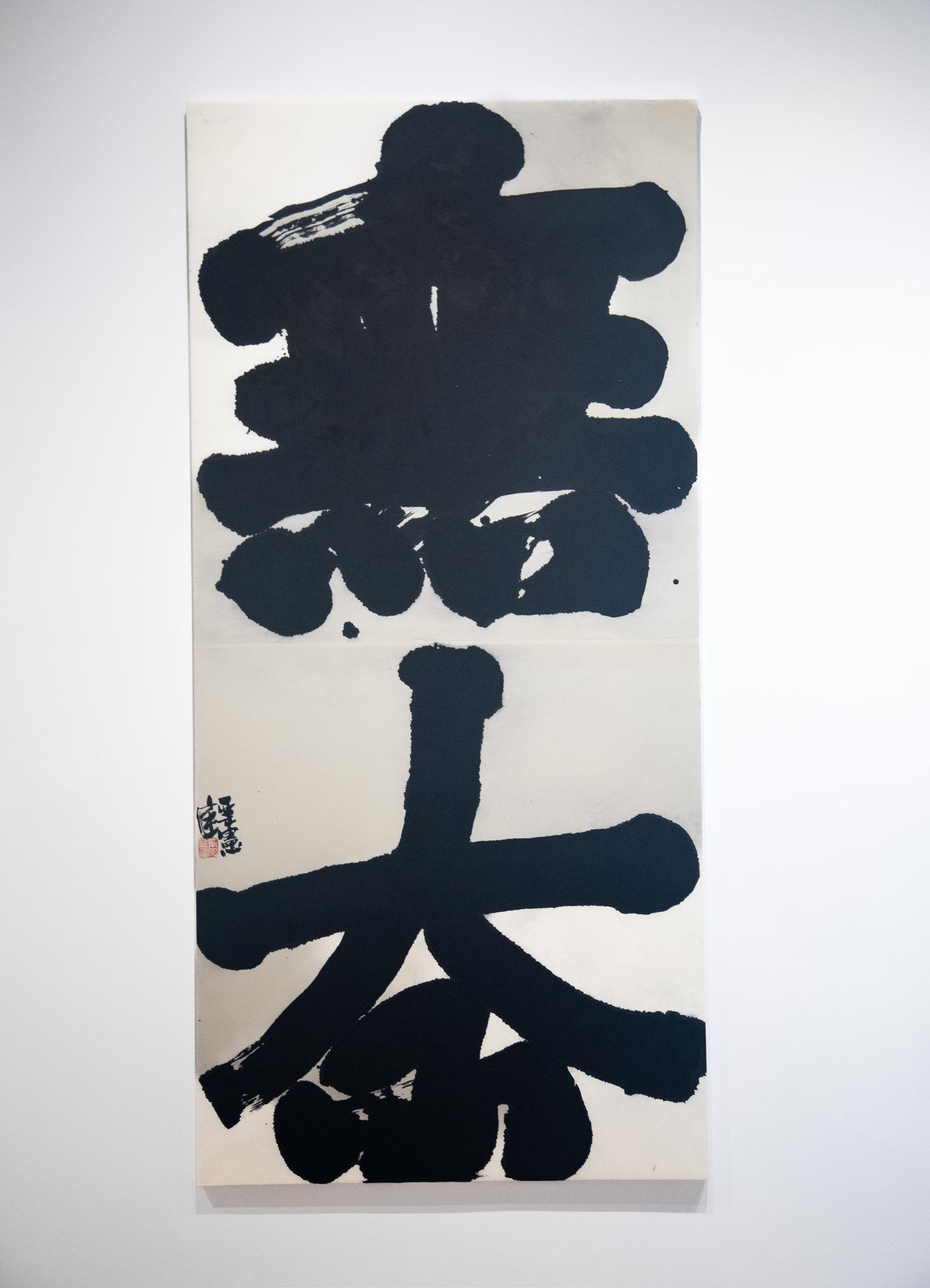
奈无 To Have No Choice, 2025
Ink on xuan paper
40 x 38 in, 110.6 x 96.52 cm each; 40 x 76 in, 110.6 x 193.04 cm overall

BIOGRAPHY OUYANG JIANGHE 欧阳江河
b. 1956 in Luzhou, China; Lives and works in Beijing, China
Ouyang Jianghe, a nationally renowned poet and culture critic who lives in Beijing, was born in 1956 in Luzhou, Sichuan Province. His ancestral hometown is Hebei, China.
His works include over 200 poems, as well as articles on poetry and reviews of contemporary fine art, music, film, and drama. His published books include the poem collection Through the Glass of Words, the collection of poems and criticism Who Leave, Who Stay, the collection of reviews and essays Standing on the Side of Fiction, and the poem collection Tears of Things.
Ouyang’s poetry accentuates originality of thought and hybridity of language, emphasizing the connection between personal experience and public realities.
Ouyang has made broad and lasting influence among his peers, whereby he is recognized as one of the most important poets of China since the 1980s.

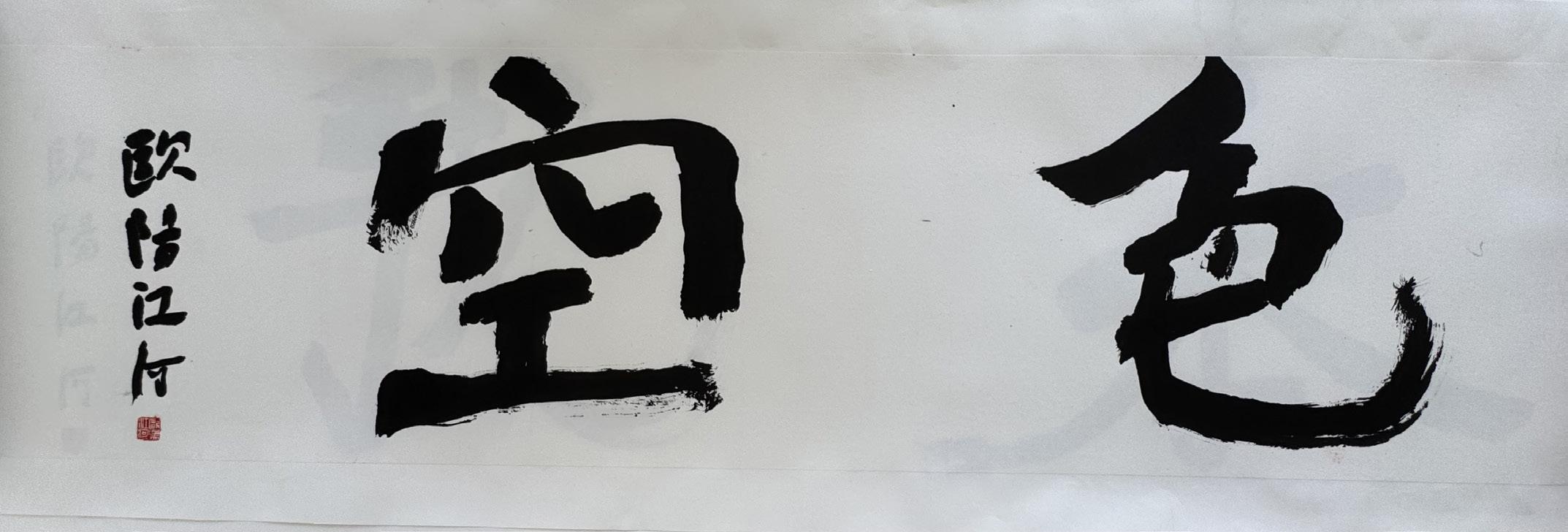
Form and Emptiness, 2025
Ink on xuan paper
13.5 x 50 in | 34.3 x 127 cm
Framed: 19.25 x 58 in | 48.9 x 147.3 cm
色空

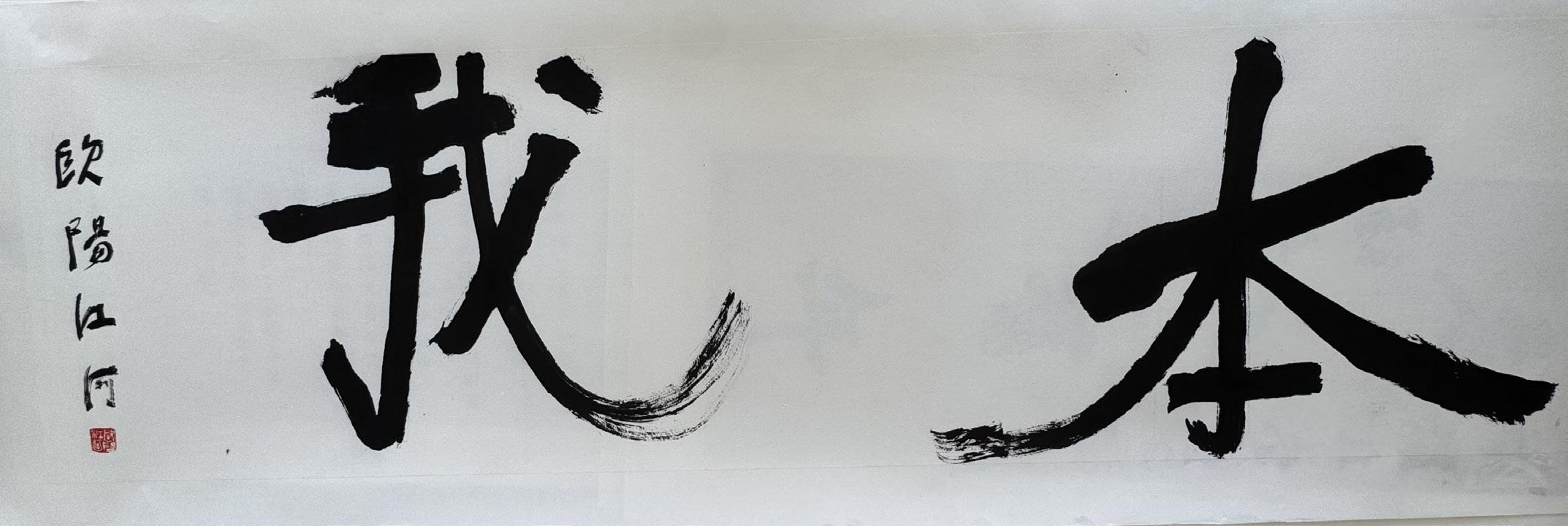
13.5 x 53.25 in | 34.3 x 135.3 cm
Framed: 19.25 x 61.5 in | 48.9 x 156.2 cm
本我 The Original Self, 2025
Ink on xuan paper


古人秉燭夜遊
The ancients carried candles wandering by night, 2025
Ink on xuan paper
13.5 x 50 in | 34.29 x 127 cm
Framed: 19.25 x 58 in | 48.9 x 147.3 cm


Heaven holds its Grand Mandate, and man holds his Grand Mandate, 2025 Ink on xuan paper
16.5 x 15.5 in | 41.9 x 39.4 cm
Framed: 22.5 x 21.5 in | 57.2 x 54.6 cm

BIOGRAPHY XI CHUAN 西川
b. 1963 in Jiangsu, China; Lives and works in Beijing, China
Xi Chuan (“West Stream,” pen name of Liu Jun 刘军) is a prominent poet, essayist, translator, and editor whose career traces—and helps shape—the evolution of Chinese poetry after the “Misty” generation.
Raised in Beijing, he studied English at Beijing University. In 1988 he co‑founded the unofficial poetry journal Qingxiang (Tendency), shut down after three issues, and from 1990 to 1995 served as an editor at the underground publication Xiandai Hanshi (Modern Chinese Poetry). He is currently a co‑editor of Dangdai Guoji Shitan (Contemporary World Poetry).
Parallel to his poetic production, Xi Chuan has published essay collections, criticism, a play, and translations of (among others) Pound, Borges, and Miłosz, extending his exploration of how ideas travel across linguistic and cultural systems. His distinctions include the Modern Chinese Poetry Award (1994), the Lu Xun Prize for Literature (2001), the Zhuang Zhongwen Prize for Literature (2003), Sweden’s Cikada Prize (2018), and the Tokyo Poetry Prize (2018).
Xi Chuan teaches classical and modern Chinese literature at the Central Academy of Fine Arts and lives in Beijing. Previously, he taught Western literature in Chinese translation and introductory English. He has held appointments at universities such as New York University and the University of Victoria.


峨峨高山首 悠悠萬里道
Towering, towering stand the mountain peaks. Winding, winding stretches the road of ten thousand li., 2021
Ink on xuan paper
35.5 x 151.1 cm | 14 x 59.5 in
Framed: 49.5 x 165.1 cm | 19.5 x 65 in
WRITTEN:
“峨峨高山首 悠悠萬里道
The towering peaks stand tall, endless stretches the road ahead”

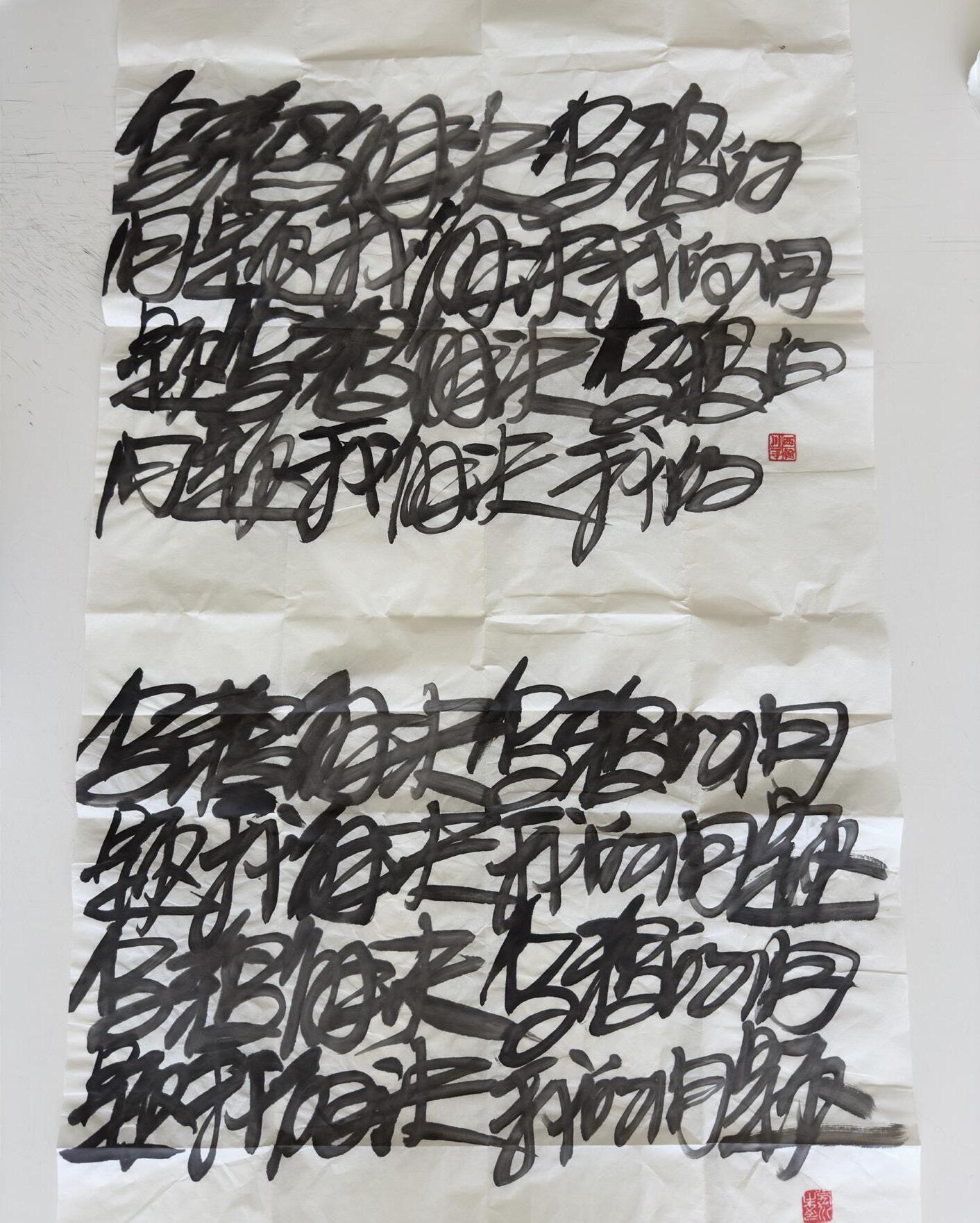
Crow烏鴉, 2021
Ink on xuan paper
WRITTEN:
“烏鴉解決烏鴉的問題,我解決我的問題;烏鴉解決烏鴉的問題,我解決我的
Crows solve crows’ problems, I solve mine; Crows solve crows’ problems, I solve mine.
烏鴉解決烏鴉的問題,我解決我的問題;烏鴉解決烏鴉的問題,我解決我的问题
Crows solve crows’ problems, I solve mine; Crows solve crows’ problems, I solve mine.”

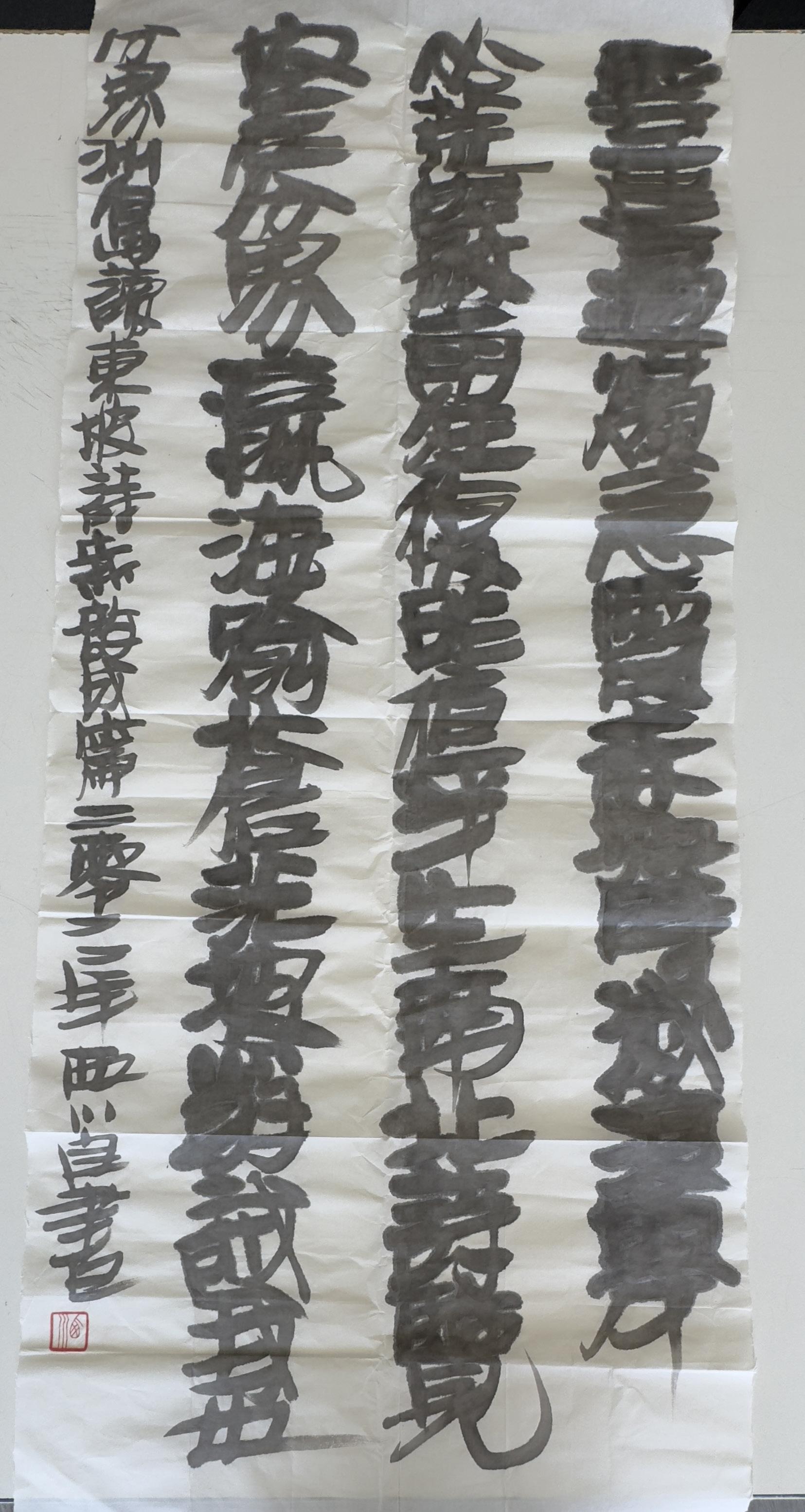
分界洲島讀蘇東坡新韻成篇
New Verses Upon Reading Su Shi on Boundary Island, 2021
Ink on xuan paper

分界洲島讀蘇東坡新韻成篇
New Verses Upon Reading Su Shi on Boundary Island, 2021
WRITTEN:
“雲連過嶺急,霞赤知時滅。
浪舉必荒原,雨狂復昨夜。
半生南北詩, 攬空在分界。
贏海喻蒼茫,坡翁誡我也。
- 分界洲島讀東坡詩新韻成篇.
Clouds rush across ridges in fierce procession, the rosy sky fades—it knows its time. Waves rise, and wasteland follow; The storm returns, just like last night.
Half my life, I’ve written poems, Wandering north and south with no end. To win the sea is to name the vast unknown, Old Donpo once warned me, in a solemn tone.
–A New Rhyme Reading Su Dongpo’s Poetry at Fenjiezhou Island”

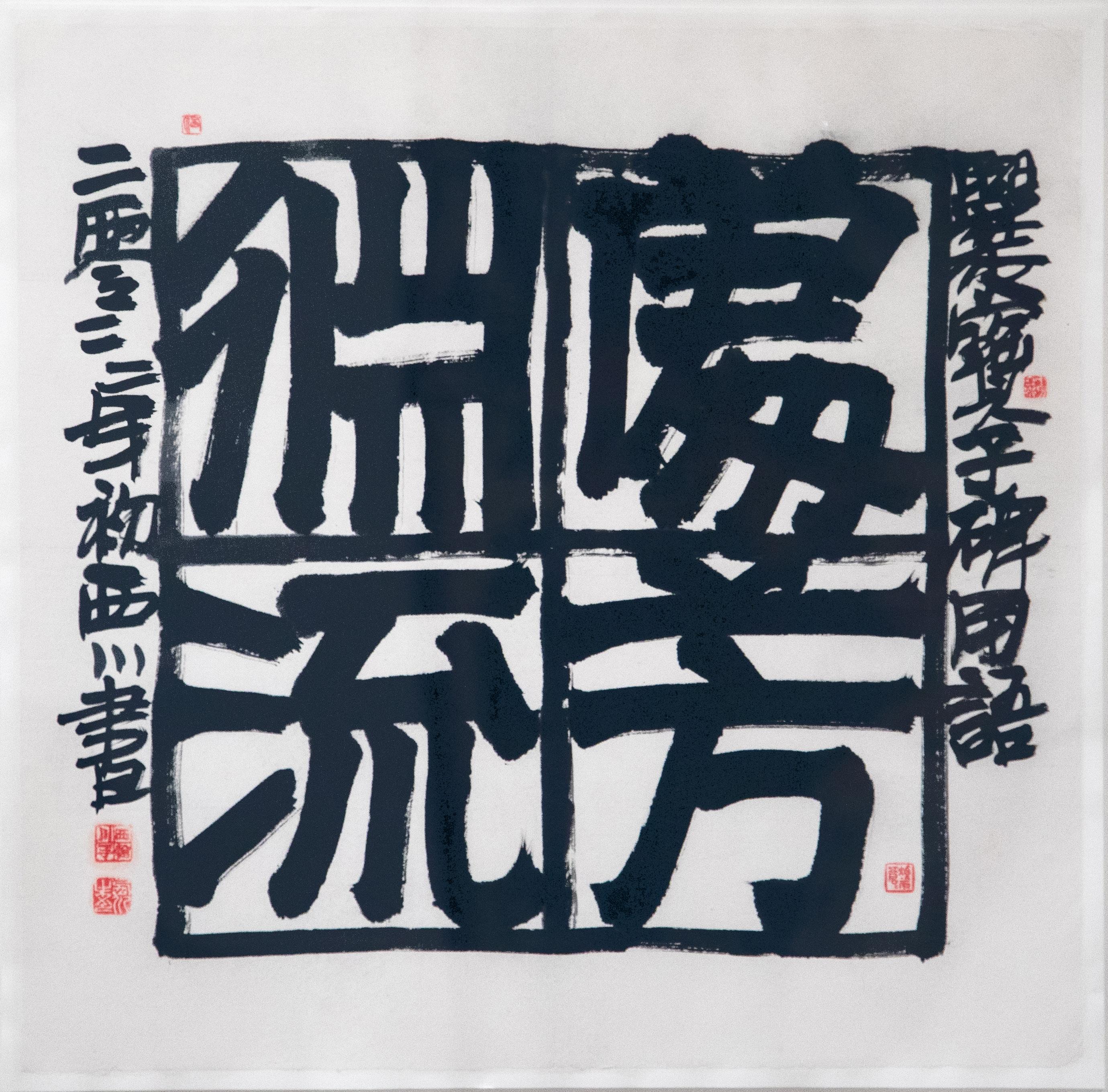
處淵流芳 Abiding in the depths, virtues flowing afar, 2022
Ink on xuan paper
72.4 x 73 cm | 28.5 x 28.75 in
Framed: 85 x 85.75 cm | 33.5 x 33.75 in

BIOGRAPHY
YU JIAN 于坚
b. 1954 in Kunming, China
Yu Jian, courtesy name Zhibai, is a poet, writer, photographer, and documentary filmmaker. He was 12 years old when the Cultural Revolution began, causing his schooling to be interrupted. At 16, he was assigned by the state to work in a factory. In 1980, he was admitted to the Department of Chinese Language and Literature at Yunnan University through self-study, earning a Bachelor of Arts degree.
Yu Jian began writing poetry in the early 1970s. In 1979, he co-founded the mimeographed literary magazine Underground Fire (Dihuo) with several writers in Kunming. In 1985, he joined other Chinese poets to launch the printed poetry journal They (Tamen). He has since published over 50 works in China and internationally, including Sixty Poems (1989), The Poetry of Yu Jian (2001), Notes on Scraps (2002), Poetry and Images (2003), Only the Sea Vast as a Curtain (2006), Who Is He (2013), and Wanderings (2023), as well as essay collections, photography books, and documentary films. His works have been translated into English, French, German, Spanish, Galician, Dutch, Italian, Japanese, Hindi, Swedish, Danish, Icelandic, Serbian, Russian, Korean, Greek, Bulgarian, Polish, and more.
Selected Accomplishments:
Yu’s 2004 documentary Bise Station was selected for the Silver Wolf Competition in the First Appearance section at the International Documentary Film Festival Amsterdam (IDFA).
Yu Jian has received numerous literary awards, including the Lu Xun Literature Prize, the Zhu Ziqing Essay Prize, the Chinese Literature Media Outstanding Writer of the Year Award, and Taiwan’s Genesis Poetry Award, among many others.
The German translation of Yu’s selected poems, Dossier 0, was awarded first place in the Weltempfänger list of top African, Asian, and Latin American literary works by Litprom (Society for the Promotion of Literature from Africa, Asia, and Latin America, Germany). Dossier 0 was also selected for inclusion in The Big Red Book of Modern Chinese Literature, published by W.W. Norton & Company.
The French edition of The Implied Rose was shortlisted for the Découverte Poetry Prize in France.
Long poem Lament for Dianchi Lake received the Student Translation Prize from the journal World Literature Today at the University of Oklahoma.
Yu Jian has also held photography exhibitions in Yunnan, Taiwan, Macau, Paris, and Spain.

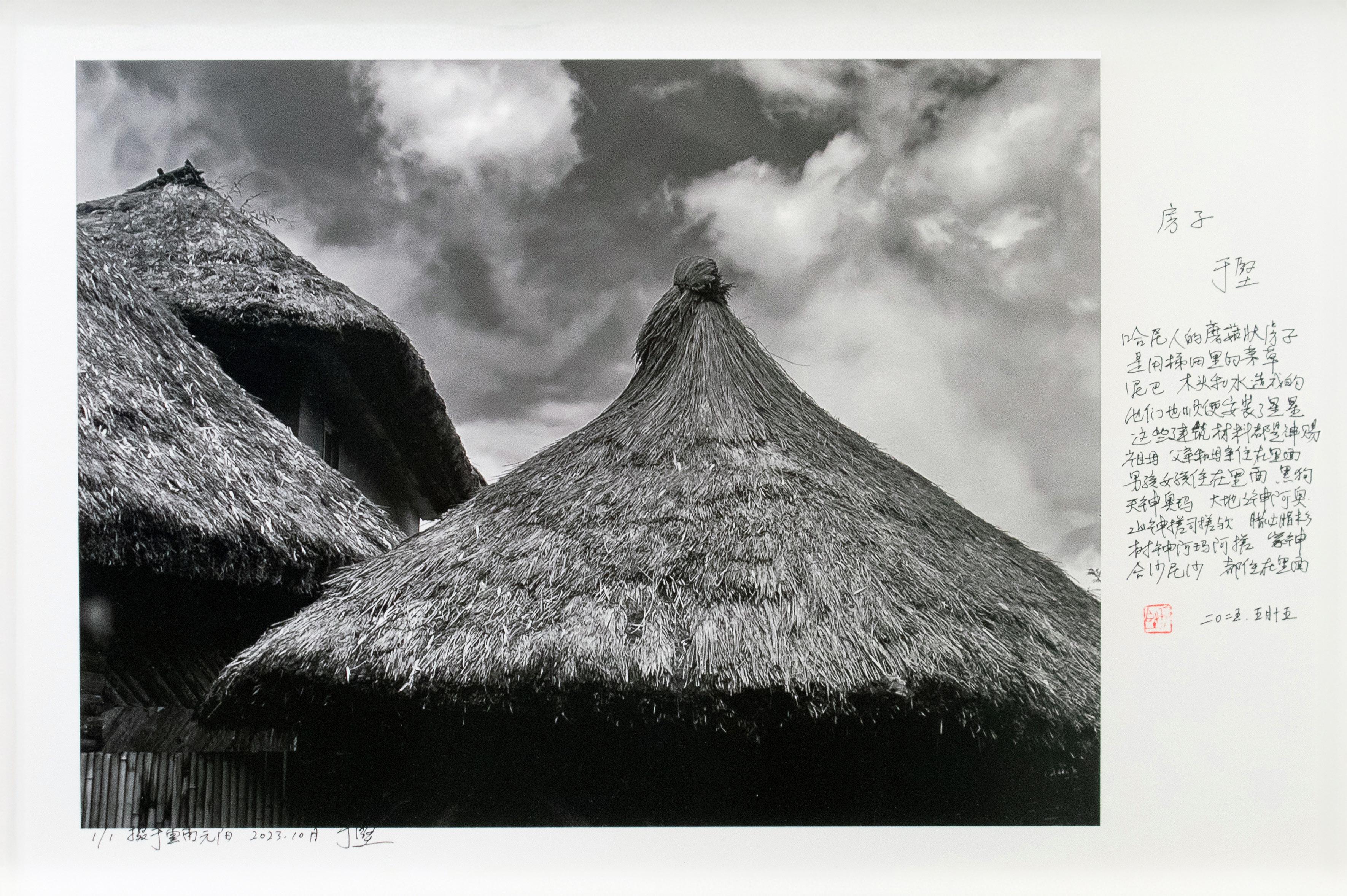
Writing on photographic print
Photo: 50 x 80 cm, 19.5 x 31.5 in
Mounted: 70 x 100 cm, 27.5 x 39.5 in
Framed: 58.4 x 85.1 cm, 23 x 33.5 in
房子 House, 2025

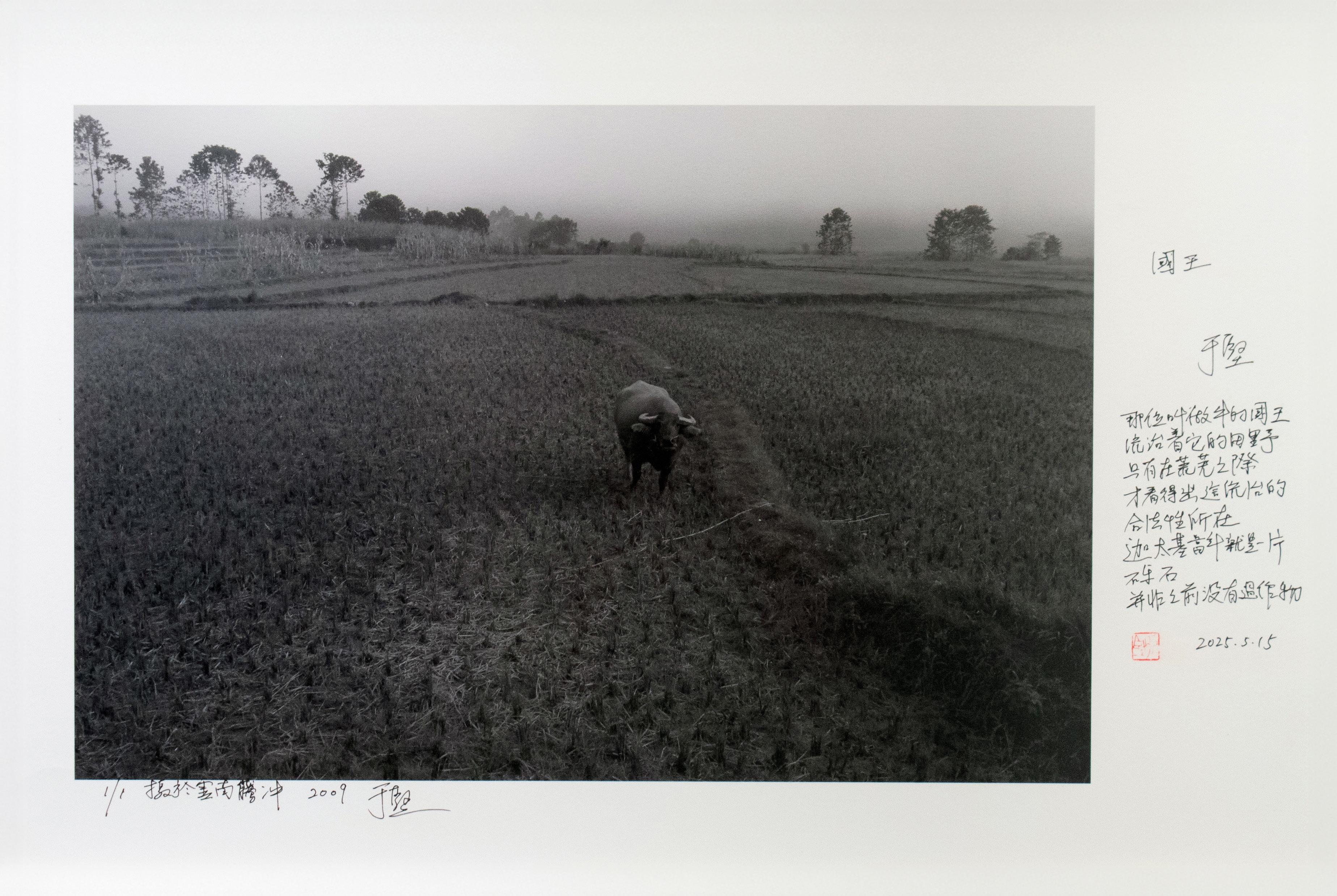
Writing on photographic print
Photo: 50 x 80 cm, 19.5 x 31.5 in
Mounted: 70 x 100 cm, 27.5 x 39.5 in
Framed: 58.4 x 85.1 cm, 23 x 33.5 in
国王 King, 2025

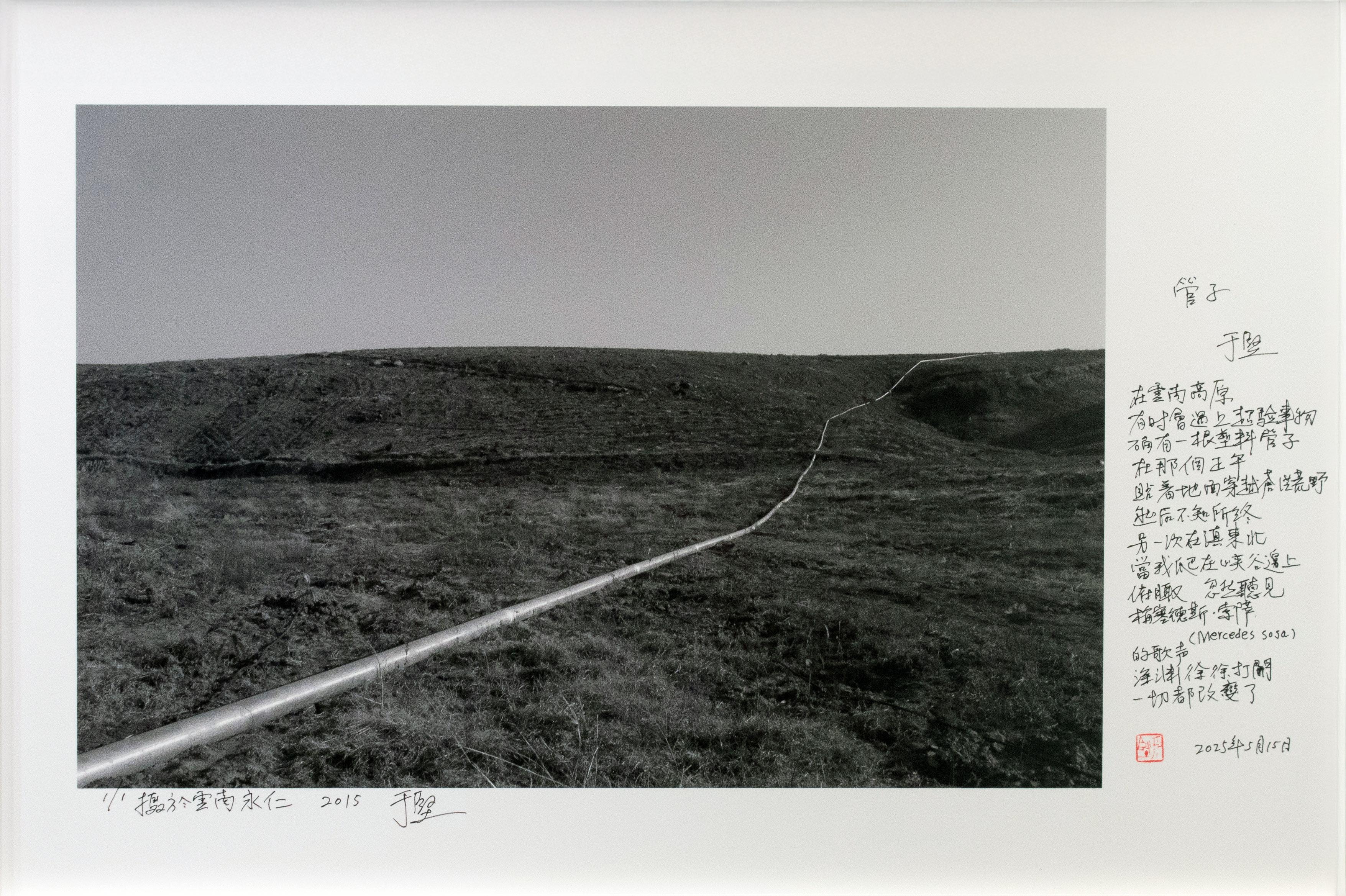
Writing on photographic print
Photo: 50 x 80 cm, 19.5 x 31.5 in
Mounted: 70 x 100 cm, 27.5 x 39.5 in
Framed: 58.4 x 85.1 cm, 23 x 33.5 in
管子 Tube, 2025


Writing on photographic print
Photo: 50 x 80 cm, 19.5 x 31.5 in
Mounted: 70 x 100 cm, 27.5 x 39.5 in
Framed: 58.4 x 85.1 cm, 23 x 33.5 in
狮子 Lion, 2025
